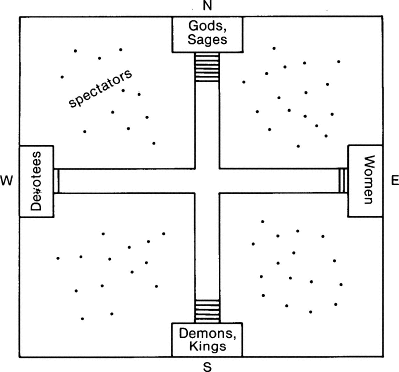Shivpur’s Visual Allegory
Although the royal Ramlila cycle presents a striking example of spatial commentary, even modest local productions lacking resources for the expansive environments constructed at Ramnagar have evolved methods of staging that comment no less effectively on Tulsi's text. At Shivpur, a village on the northwestern outskirts of Banaras, virtually the entire Ramlila transpires within a large rectangular enclosure oriented to the four directions. Each of the walled sides has an elevated dais at its center: the one to the north is approached by seven steps and surmounted by a throne; the southern dais has five steps and likewise bears a throne; the eastern dais is raised only two steps; and the one to the west is but a single step above ground level. These platforms are linked by raised walkways that intersect at the center of the enclosure, dividing the performance area into four rectangles (figure 31).
According to Bhanushankar Mehta, who has studied this production, the northern dais with its high stairway (reflecting traditional cosmology and the sequence of seven steps through which Tulsi narrates his tale) is the seat of divine characters and sages. The lower throne-dais to the south, with its staircase symbolic of the fivefold material world, is the seat of worldly kings—Dashrath, Janak, Bali, Sugriv, Vibhishan, and of course, Ravan. The orientation of these two platforms conforms to symbolic geography, the north being associated with the gods and immortality, the south with mortality, the underworld, and demons. The eastern platform is the seat of female characters: Kaushalya (whom Tulsi salutes as "the eastern sky . . . in which appeared Ram's beautiful moon"; 1.16.4-5), Ram's stepmother Kaikeyi, Janak's queens, and Sita (who is from the eastern kingdom of Videha); it serves as both the flower garden in Janakpur (the site of Ram and Sita's first meeting) and the Ashok grove in Lanka (the garden of their separation). The western and lowest platform, said to represent humble devotees, is used by the Ramayanis.[149]
Most of the action of the play transpires on the bisecting runways that link these cardinal platforms and literally chart the "goings of Ram" (Rama-ayana —a traditional interpretation of the Sanskrit epic's title). The main axis of the narrative is the north-south path, along which the Lord descends from his heavenly abode to engage in adventures that eventually carry him to its opposite pole for a decisive con-
Figure 31.
The Shivpur Ramlila grounds
frontation with his archrival. His mission accomplished, he returns in triumph and reascends the seven steps to occupy his throne in Ayodhya. Spectators occupy the four quadrants bounded by the runways, which place them in the midst of the story: in a world visited and transformed by Ram.
Mehta is a Banarsi physician and lifelong Ramlila aficionado whose writings on the pageant occasionally appear in the local press or the popular Hindi weekly Dharmyug . When he attended the Shivpur production, he was struck by the peculiar tetradic symmetry of its staging, which immediately reminded him of the overall design of the Manas epic. Like Tulsidas, the creators of this neighborhood pageant seem to have sought to frame the deeds of Ram within a geometric paradigm, each side of which highlights a key aspect of the whole. Assuming each of the platforms to correspond to one of the ghats of the Manas Lake, Mehta developed an elaborate chart of correspondences that relates the foursquare design to other symbolic tetrads invoked by epic commentators (table 1). Such analysis reflects the ingenuity and penchant for all-encompassing systematization of traditional scholarship, yet it is not altogether farfetched. The Shivpur Ramlila is itself a product of the
TABLE 1 | ||||
North | East | South | West | |
Stage | Divine | Goddess | Royal | People's |
Goal | Liberation | Pleasure | Profit | Duty |
Path | Detachment | Devotion | Knowledge | Ritual |
Teller | Shiva | Bhushundi | Yajnavalkya | Tulsidas |
Hearer | Parvati | Garuda | Bharadvaj | Devotees |
Physical locus | Soul | Heart | Forehead | Body |
Worship | Wisdom | Surrender | Actions | Service |
same tradition, and its distinctive layout clearly suggests an underlying symbolic logic.
In other details, the Shivpur production resembles many other Banaras Ramlilas : it lasts thirty days; features Ramayanis who chant each line and players who periodically interject dialogues; and utilizes a directing vyas , who stands with script-book in hand, prompting the actors. But in its original and symbolic groundplan, which translates into visual terms the epic's own implicit structure, this neighborhood Ramlila seems no less sophisticated than its royal cousin at Ramnagar, and it contradicts the notion that local productions are only vulgarized and scaled-down versions of the royal pageant.[150] If Ramnagar's patrons expanded their lila into a macrocosm that ultimately encompassed and re-envisioned their kingdom, Shivpur's sponsors, more constrained in their means, created a microcosm not unlike the mystical groundplan of a medieval Hindu temple (sthala mandala[*] ), which likewise embodied and externalized the theology of the builders. The aim in each case was the same: the spatial articulation of myth.
From the devotee's point of view, the Ramlila 's tangible, encompassing world of text-made-flesh bids fair to represent the ultimate realization of the Manas . Some would go further and accord the lila a kind of primacy. A Ramnagar connoisseur once remarked to me that, although it is conventionally held that the pageant is a commentary on the Manas , "I sometimes feel that it is really the other way around and the Manas itself exists to explain our Ramlila! That's how living a thing this lila is for us."[151] If Katha , as some of its practitioners suggest, presents the epic as a mirror for our contemplation, then Ramlila invites us, Alice-like, to step into that mirror (as the rasik adept ultimately enters the magic realm of his visualization) and experience a world transformed.
